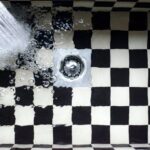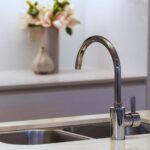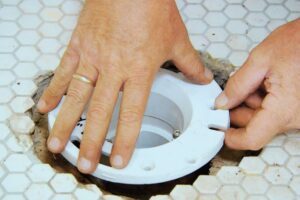When the kitchen sink clogs, it can be a pretty stressful situation. There are many different reasons why your sink might get clogged, but no matter what the cause, it’s essential that you know how to handle it in a way that won’t result in any damage to your home or plumbing.
You can try some basic troubleshooting techniques yourself before calling for help. What do you do when your kitchen sink is clogged?
- Reset the garbage disposal.
- Use a plunger to remove the clog.
- Only use natural drain cleaners.
- Remove or clean the P-trap and use a plumbing snake.
- Call a plumber for help.
Read on to learn some of the reasons why your kitchen sink might get clogged and tips on how to fix it so that you can get back to enjoying your kitchen again.
Common Causes of Kitchen Sink Not Draining

If you’ve ever had a clogged kitchen sink, you know it’s no fun. But did you know that there are many different reasons why kitchen sinks can become clogged? Some of its most common causes are as follows:
1. Food Debris
The most common reason for a clogged kitchen sink is food debris. If you’re not careful when rinsing dishes and scrubbing pots, you might leave behind bits of food that will cause your drain to get clogged. Food debris can be anything, but the most common foods that get stuck in the drain are:
Egg Shells
Egg shells are too hard to break down in the drain, so they can quickly get stuck in the pipes and cause a clog. The best way to prevent this is to ensure that you remove all eggshells from your dishes before washing them.
Starches
Four of the most common foods responsible for clogged kitchen sinks are rice, potatoes, beans, and pasta. And when starches come into contact with water, they undergo expansion, producing a glue-like substance that can clog pipes.
Coffee Grounds
Remember that coffee grounds clump together rather than dissolve in water. After some time, the grounds can accumulate inside the drains of your sink, causing clogs that can prevent the drains from functioning correctly.
So it’s better to throw away used coffee grounds or add them to the compost pile instead.
Tree Roots
If you have a tree or large bush near your home, it’s growing its roots towards your pipes. When this happens, they can easily get lodged in the drain and cause a clog.
The best way to prevent this is to ensure that you keep the area around your pipes clear of tree roots and other debris.
Tree roots like to grow in pipes, especially if they’re made of concrete or clay. If you have an older house with an outside pipe leading from the sewer system to your home’s plumbing, you might want to check for signs of tree root intrusion every once in a while.
2. Grease Buildup
Grease is another common culprit, especially in commercial kitchens where oil and grease are abundant. If you have lots of grease in your drain, it can build up over time and eventually cause the pipe to clog. Grease particles are also tough to remove because they don’t break down quickly.
Grease is so challenging to remove that it’s often necessary to hire a professional plumber to do it for you when you have a clogged kitchen drain. So if you want to avoid this expense and inconvenience, you should try to keep your grease out of the drain in the first place.
3. Children’s Toys
In addition, most kitchen sink clogs result from small objects mistakenly flushed down the drain, especially if you have children.
To clean up the pipes of any miniature toy dinosaurs or tiny race cars, you’ll most likely need the assistance of a plumber because you will need to remove either the P-trap or the J-trap.
This can cause the drain to clog, leading to more significant problems. Food particles can also attract bugs and other pests that like to live in dirty areas.
4. Others
They can also include things you don’t think about, like sand or dirt from outside or even paper towels (which don’t break down easily). These particles get stuck in the trap under your sink and prevent water from flowing freely through it.
How to Unclog a Double Kitchen Sink with Standing Water

Unclogging a double sink can seem like a daunting task. It’s not hard, though. And I’m going to tell you how!
1. Reset the Garbage Disposal
A few contributing factors might result in a clogged kitchen sink. And needing to reset your garbage disposal can be one of those things. So if you’re having trouble unclogging your kitchen sink, hitting the reset button on your garbage disposal might be a good idea.
Check If the Garbage Disposal Is Overheated
If the garbage disposal doesn’t work, check if it’s overheated. But first, ensure the switch is off. Next is to flip the switch on once more and see whether or not this solves the problem.
Do Not Put Eggshells or Coffee Grounds in the Garbage Disposal Unit
Garbage disposals are convenient and make our lives easier. They virtually liquefy leftover food, saving you from the inconvenience of a clogged sink. But if you want your garbage disposal to function correctly and last a long time, you shouldn’t put anything like eggshells or coffee grounds.
If turning the garbage disposal back on doesn’t solve the problem, the following approach is to use a plunger to clear the clog.
2. Use a Plunger to Remove the Clog
If you’re having trouble unclogging your kitchen sink, try using a plunger to push and remove the clog.
Always remember that a plunger needs water pressure to work. As we’re working with a double sink, block the unclogged drain using a rag. When done in this manner, the pressure you apply over the clogged kitchen sink will work effectively. Here’s how to do it:
- Remove any standing water in the clogged sink, and leave just enough to submerge the plunger cup completely.
- Put the plunger cup over the clogged kitchen drain and establish a good seal around it. Start by pushing the plunger up and down six times without releasing pressure. Your kitchen sink is unclogged if the water drains when you remove the plunger.
- Repeat the steps above if there’s any remaining water in the sink. Otherwise, move on to the following unclogging method.
Plungers are helpful because you can use them on all types of clogs, even those that have been there for some time. But if you’ve already tried plunging and still aren’t able to make progress in clearing out your drain, it’s probably time to move on to another method.
3. Only Use Natural Drain Cleaners
There are numerous all-natural solutions available for unclogging a kitchen sink. Some commercial drain cleaners and clog dissolvers can erode your draining pipes. If you misuse them, they can particularly harm the tubes that drain water from your home.
Did you know that most commercial clog removers contain sulfuric acid, sodium hydroxide, and sometimes lye or caustic soda? These ingredients are highly corrosive to organic materials, including the pipes in your drainage system.
So why not try the natural alternative route instead?
Baking Soda with Vinegar
This combination is a popular home remedy for a clogged kitchen sink without using any harsh chemicals.
It’s easy to use and works on most clogs, including hair, grease, and soap scum. You can also use this method if there’s no plunger available or if you want to avoid the expense of buying any special tools.
All you need to do is pour a cup of baking soda down the drain, followed by one cup of vinegar. Next, leave it for about an hour before flushing with temperature water. If this doesn’t work, repeat the process until all clogs are removed.
Baking Soda with Salt
The baking soda and salt combo is another natural and straightforward method to unclog a kitchen sink without any real effort. You must mix a cup of baking soda with 1/2 cup of salt and pour it down the drain. The mixture will react with whatever is clogging your gutter and cause it to dissolve.
But here’s the catch: you’ll need to wait anywhere from four to six hours for the salt and baking soda mixture to do its job. After the allotted time, you must wash the mixture with temperature water.
But if you’ve tried everything to unclog the sink, and none of them work, maybe it’s time to put on your work clothes and get your hands dirty.
4. Remove or Clean the P-Trap and Use a Plumbing Snake
Once you’ve removed or cleaned the P-trap, use a plumbing snake to push through the drain and remove whatever is clogging it. This method is suitable if you don’t want to spend money on a plumber but still want to unclog your drain.
Clean or Replace the P-trap
The P-trap is a curved pipe that runs under your sink. It is used to prevent sewer gases from coming into your home while simultaneously preventing water from backing up into the sink.
You can remove the P-trap and clean it with soap and hot water. However, if this doesn’t work, you may need to replace it altogether.
After removing the clog, run water down the drain to flush out any residue. Contact a plumber for assistance if your kitchen sink is still slow after using these methods.
How to Fix a Kitchen Sink Clogged Past the Trap
5. Call a Plumber for Help
If your sink is still slow to drain after trying the four methods above, it could signify a more complicated plumbing problem. Contact a plumber immediately if there are any signs of damage or leaks under your sink. A plumber can help you identify the problem and fix it fast.
So whenever you have a plumbing problem that seems very time-consuming or difficult to fix on your own, call a professional plumber who will take care of it for you.
Frequently Asked Questions – Kitchen Sink Keeps Clogging

Will a Clogged Sink Fix Itself?
Unfortunately, some property owners ignore clogged kitchen sinks hoping that the obstruction will clear up on its own. However, this does not always happen, as clogged drains usually worsen over time.
Why Is My Sink Backing Up on Both Sides?
When one or both sides of your double kitchen sink become clogged, the problem is usually caused by either a clog in your garbage disposal or an obstruction in the main drainage water line.
Why Is My Sink Backing up When I Run the Garbage Disposal?
A clogged drain pipe is one of the most common causes of garbage disposal backing up into another sink. The solution to this issue isn’t too complicated — you should be able to unclog the drain using a regular plunger.
Will Boiling Water Unclog a Sink?
If you have metal pipes, try using hot water to see if that helps dislodge the clog. And if the clog is made up of grease, pouring boiling water down the drain into the trap may help dissolve it.
Will Salt Unclog a Sink?
While running hot water through the pipes will help remove debris, using coarse salt can scour the inside of your pipes. Salt eliminates more material than simply running hot water through them. After draining the sink, throw a half-cup of salt down the drain before pouring hot water.
Conclusion – Unclogging a Kitchen Sink
Kitchen sinks can get blocked and clogged at any time of year. But it doesn’t have to be overwhelming. Remember that anyone can quickly unclog their sink with the right tools, patience, and persistence.
It’s a good idea to check your sink every once in a while for signs of clogging. But if you’re not comfortable with DIY fixes or don’t have the time or tools to unclog it yourself, then it’s probably best to call a professional.









![Read more about the article Hot Water Not Working but Cold Is [How to Fix]](https://homecarezen.com/wp-content/uploads/2021/10/hot-water-not-working-but-cold-is-300x200.jpg)